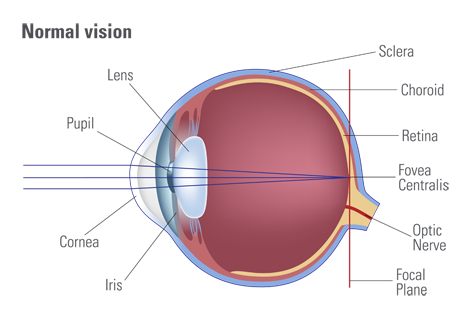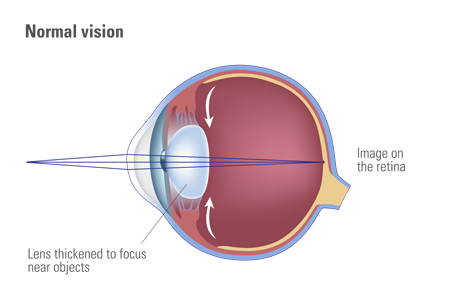
About your vision
|
The eye is often considered the most important sensory organ of the human body. Seventy percent of our sensory cells are located on the retina with the muscles that control eye movement considered to be the most active muscles in the human body. The eye is composed of several distinct anatomical structures which include the cornea, lens, pupil, iris, aqueous humor, vitreous humor, sclera, choroid, zonule fibers and retina (Figure 1). |
|
|
|
|
|
Figure 1: The structure of the eye. |
Figure 2: Accommodation of the lens. |
|
Light enters the eye through the anterior (or front) part of the eye where it passes first through the cornea and then lens which focus the light into a distinct beam. This light beam then moves through the middle of the eye and ends up on the back of the eye (retina) which is compsed of a light-sensitive membrane that translates the light into electrical signals which are, in turn, sent to the brain through the optical nerve (Figure 1). The cornea is the outermost transparent layer in the anterior part of the eye and is responsible for most of the focus or dioptric power. The curvature of the cornea determines how well the light is focused. After light leaves the cornea it passes through the lens which is flexible and can change shape to help you see at different distances (accommodation) (Figure 2). |
|

YOUR VISION |
Z-CATARACT
|
FIND A DOCTOR |
FOR PROFESSIONALS |
Important Safety Information
Cataract and lens surgery is one of the most frequently performed and safest operations in medicine today. However, make sure to discuss your medical history and medication use with your doctor prior to scheduling a surgery. The use of cardiac or blood thinning medications such as Warfarin should be discussed with your doctor. Complications from cataract surgery can occur as surgeries of any kind will carry some risk. While femto cataract surgery is considered a safe and effective treatment option for most people, your doctor may suggest an alternative treatment that best fits your individual needs.
Ziemer FEMTO LDV lasers are prescription medical devices that can only be used by accredited eye care professionals for cataract and other approved surgical procedures. Only a trained eye care professional can determine if a FEMTO LDV laser procedure is appropriate for your condition. Talk to your doctor if you have a family history of keratoconus, glaucoma, other eye-related diseases, diabetes, a history of herpes simplex or herpes zoster keratitis, retinal detachment, severe allergies or have had changes in your vision over the past year.
Results may vary for each individual patient due to the surgical operation and the type and placement of artificial lens. Speak with your doctor about which artificial lens may be right for you. In order to reduce post-operation complications, make sure to follow your doctors instructions for eye care. If you your surgeon has prescribed drugs to take before or after surgery, follow the dosage instructions. After surgery, avoid risky activities such as sports, face painting, heavy lifting, contact with water etc.













